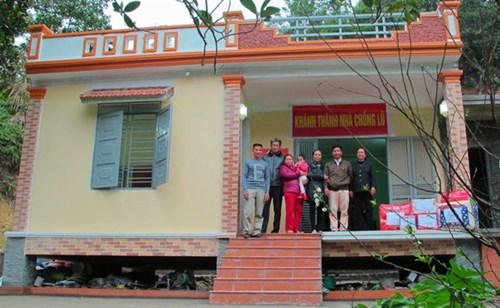More widely known by her nickname, Jang Keu, the smiley 38-year-old is a jack of all trades – from organizing several fundraising events for the project, to traveling thousands of kilometers to flood-prone areas to meet needy people, from connecting and collaborating with relevant partners, to supervising the project’s implementation. Alongside the Flood Resistant Houses project, Giang also heads her two own businesses, which provide significant financial support for her charity project.
Launched in November 2013, Flood Resistant Houses has helped residents build safe houses and earn a living, thus relieving the impacts of natural disasters and climate change.
    |
 |
| A flood resistant house. Photo: vietnamnews.vn |
The factor that sets Flood Resistant Houses apart from other charity and social projects is the direct participation of needy people. They are the ones involved in every steps of the process, from planning, to contributing to costs, designing their future homes, and even building the houses themselves.
“Having experience from working on several NGO projects before, I understand deeply that it’s the beneficiaries playing the key role in changing their own lives. That’s why, alongside providing assistance so needy people can build their own homes, Flood Resistant Houses also inspires people to be motivated, helping boost their confidence and independence,” Giang said.
Therefore, any family that agrees to join Flood Resistant Houses, will be asked to contribute 50 percent of the building cost, while the remainder will be donated by the project. Each house costs between 50 and VND 80 million (USD 2,200 to 3,500).
“Each building project has the participation of the beneficiary, Flood Resistant Houses, local authorities, and building material suppliers,” Giang said.
“To avoid problems, we do not give money directly to the households. Instead, we pay the suppliers and for other expenditures,” the chief of the Flood Resistant Houses project said.
The design of these houses is another important factor.
To be able to withstand natural disasters, mostly typhoons and flooding, these houses need to be specially designed: on stilts and with a loft, or two-storey houses where the upper level can be used for storage during floods.
Additionally, based on the geological conditions of every region, as well as the habits and living conditions of each family, each house will be individually tailored.
“While houses for families that raise goats should have staircases for the animals to reach upper levels, ones for households that raise cows should have a covered space,” Giang explained about the different house designs.
So far, Flood Resistant Houses has presented eight designs, mostly created by architect Dinh Ba Vinh, another key operator of the project.
Because the recipients can join every step of the project, including the design stage, some houses have the potential to stand out.
“The house can be bright blue with a yellow door. However, it doesn’t matter because that is their house. They can do whatever they want to do. The project will ensure that the house is safe and stable,” Giang said.
The project was officially launched after successfully completing five flood-resistant houses in Son Thinh commune, Huong Son district in Ha Tinh.
Since then, the project has done an amazing amount of work – more than 520 flood resistant houses were built over the past four years, mostly in seriously flood-hit provinces of Quang Ninh, Ha Tinh, Quang Nam, and Quang Binh.
As the project targets more and more needy people, a fixed annual amount of VND 2 billion (USD 87,000) from the businesses, plus donations from generous people seems not enough. However, Giang is not alone on her journey. Understanding the meaning of the project, many famous Vietnamese painters have donated their artworks, which will be auctioned to raise further funds for the charity homes.
However, at the beginning, things were not so simple.
“At our first few fundraising events, when people had yet to know about the project, my friends and I had to put up our personal properties to auction,” Giang said.
So far, the Flood Resistant Houses project has organized 10 fundraising events. At the most recent event held in Hanoi, the project raised more than VND 2.3 billion (USD 103,000), which, according to Giang, is enough to build 64 houses for victims of recent typhoon Damrey, which hit South Central provinces in October.
Next year, the project will continue to expand its assistance to families in Mekong Delta provinces.
Source: VNA